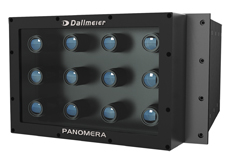Advances in the field of network-based surveillance in the last few years are astounding, writes the manufacturer Dallmeier. With High Definition and megapixel cameras, the question arose: which are more suitable for surveillance? That discussion is already outdated: A new technology, known as multi-focal sensor technology is paving the way for a hitherto inconceivable surveillance and analysis according to the firm.
When the first HD and megapixel cameras were launched onto the market, they were clearly superior to SD cameras, with much higher resolutions. HD cameras are impressive because of a technology that is derived from the field of video – that is to say relating to moving images. The roots of megapixel are in the field of static photography, even though they can reach higher pixel values than are possible with HD cameras. But before any discussions begin as to whether HD or megapixel cameras are more suitable for modern surveillance tasks, one point must be considered: Resolution on its own is not everything. To be able to use the images from surveillance cameras efficiently and analyse them, other dimensions besides resolution are important, such as effective image breakdown, recording of the overall image or analysis in the past. Whereas both HD and megapixel cameras very soon reach the limits of their capabilities in these areas, a new, multi-focal sensor technology, performs flawlessly. Unlike HD and megapixel cameras, with a single lens, the multi-focal sensor systems work with several lenses, each of which has a different focal length. Thanks to this new sensor concept, the camera can be adapted optimally to the area for surveillance, so details are still clearly visible, not only close up but also at very long distances, and individuals can be recognised. However, that is not the only way it stands apart from conventional cameras.
Image breakdown
One of the main arguments advanced by the defenders of High Definition cameras is that HD uses the wide-screen format with an aspect ratio of 16:9 compared with the 4:3 format of the megapixel cameras. This corresponds more closely to the human field of vision, and makes it possible to record yet more information laterally as well. But real scenes seldom correspond to either of these two formats. However, to cover all areas of interest, it is often accepted that unimportant expanses, such as the sky, will be captured as well. In this case, pixels and the recording and storage capacity they take up are all wasted needlessly. But there is a more elegant solution: instead of forcing a scene for surveillance into a given format, with multi-focal sensor systems there are no rigid, pre-set aspect ratios. They adapt the pixel ratio to the situation at hand! The image is split efficiently without being locked into specific aspect ratios such as 16:9 or 4:3. Thus for example aspect ratios like 5:1, 10:1 or 3:4 can be used without any difficulty.
Constant resolution
It is true that HD and megapixel cameras use progressive resolution options, but they quickly reach their limits precisely when it is important to be able to recognise details even at long distances. Roland Meier, Team Leader Panomera Multifocal Sensor Systems at Dallmeier, says: “Movies or television series like CSI often suggest to viewers that even blurry pictures can be transformed into high-quality police wanted posters with just a few clicks. But pixels are still just pixels: if there is no additional image information present, for example because an HD or MP camera only represents a person at a distance of 50m with a collection of coarse blocks, this information also cannot be ‘conjured out of thin air’ after the fact. So you are aware that something is happening here, but it is completely impossible to even recognise, much less identify a person. And that is precisely the objective of a professional video system.” So to obtain the desired information, in the past multiple cameras had to be installed at different locations. But this in turn involves higher costs: The appropriate cabling for power supply and data transmission is needed at every individual installation site, so the infrastructure costs and subsequent maintenance costs for multiple camera sites are enormous. This is where the new multi-focal sensor can help, since the resolution it offers is equivalent to about 32 times greater than a conventional HD camera. It can be used from just a single installation point to cover a huge area. Roland Meier says: “With conventional cameras, the resolution drops off as distance increases. Or to put it another way: the farther a person or object is away from the camera location, the poorer the resolution is there, so you are able to make out fewer details. In contrast, a multi-focal sensor system uses different lenses, so constant resolution can be guaranteed over the entire area under surveillance. So the resolution at 100 m is exactly as good as it is at 20m. This makes it possible to recognise people for example even from 160m.”
Permanent recording
The surveillance system is only as good as the user operating it. In contrast, a multi-focal sensor system always delivers total performance, since the whole picture (’permanent and overall’) is constantly recorded in highest resolution. Roland Meier says: “Those are three important points straight away: the whole picture is recorded, so no areas are lost, even if the operator is currently concentrating on a smaller inset. This total picture is recorded all the time, so there are no gaps in time. And finally: the recording takes place in the highest resolution, so no details are lost in the recording. Moreover, unlike PTZ cameras multifocal sensor systems do not have any mechanical parts, so there is no wear, which extends the equipment’s operating life.”
Visit www.dallmeier.com and www.panomera.com.









